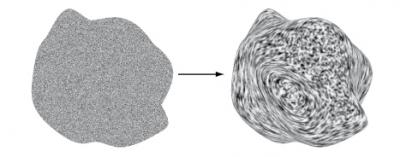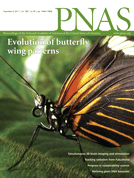据美国物理学家组织网12月8日(北京时间)报道,德国吉森大学、马普生物控制论研究所和美国耶鲁大学通过一种特殊的视幻图像实验,发现一类特殊的神经细胞在重构物体三维形状方面起着重要作用,揭示了大脑是怎样再现三维世界的。

我们认为自己生活在三维世界中,事实上这是大脑制造的一个持续不断的感觉印象。因为三维物体在视网膜上所成的图像是平面的,第三维信息已经丢失了。但我们依然体验着一个无可置疑的三维世界,人们并不清楚大脑是怎样通过视网膜信息来判断物体的确切形状的。
研究人员解释说,要通过二维图像判断目标物体的三维形状,必须依靠多种线索,如立体影像、运动视差、阴影等,大脑依靠的最重要线索就是图像形成的表面纹理。如果一种纹理对于观察者是偏斜的,这种花纹在观察者视网膜上会显出被压扁的样子,这为重建三维形状提供了重要信息。
在实验中,他们设计了一种二维的随机噪声图像,并将这种图像涂抹成特殊花纹,使它看起来有点像手指画。吉森大学心理学教授罗兰·弗莱明说:“这样涂绘出来的图像能显示真实三维世界中所没有的纹理,能选择性地刺激视觉皮质中的‘综合细胞’(complex cells),以此检测在视网膜上成像的花纹的二维方向。”
马普生物控制论研究所人类感觉、认知与行为部主管亨利奇·布尔索夫介绍说,我们让志愿者调节一种观察器来观看这些二维图像,然后报告他们看到了什么。这套装置让我们能精确重建他们所感知到的三维图形。而最突出的是我们根据细胞反应所预测的结果和志愿者感知的结果非常相似。
“我们得到了第一手数据,能清晰地看到预测图。但我们认为这种效果不会持续很久。”耶鲁大学博士生丹尼尔·霍特曼·莱斯说,这一发现分离出了大脑通过纹理判断形状的关键机制。志愿者一次盯着图案看30秒,就能改变细胞反应的方式,最终“调整”造出的随机噪声图像呈现出某种三维形状的样子,而这种图正常看起来完全是平面的。

Estimation of 3D shape from image orientations
Roland W. Fleming, Daniel Holtmann-Rice, and Heinrich H. Bülthoff
One of the main functions of vision is to estimate the 3D shape of objects in our environment. Many different visual cues, such as stereopsis, motion parallax, and shading, are thought to be involved. One important cue that remains poorly understood comes from surface texture markings. When a textured surface is slanted in 3D relative to the observer, the surface patterns appear compressed in the retinal image, providing potentially important information about 3D shape. What is not known, however, is how the brain actually measures this information from the retinal image. Here, we explain how the key information could be extracted by populations of cells tuned to different orientations and spatial frequencies, like those found in the primary visual cortex. To test this theory, we created stimuli that selectively stimulate such cell populations, by “smearing” (filtering) images of 2D random noise into specific oriented patterns. We find that the resulting patterns appear vividly 3D, and that increasing the strength of the orientation signals progressively increases the sense of 3D shape, even though the filtering we apply is physically inconsistent with what would occur with a real object. This finding suggests we have isolated key mechanisms used by the brain to estimate shape from texture. Crucially, we also find that adapting the visual system's orientation detectors to orthogonal patterns causes unoriented random noise to look like a specific 3D shape. Together these findings demonstrate a crucial role of orientation detectors in the perception of 3D shape.
文献链接:https://www.pnas.org/content/early/2011/12/05/1114619109








